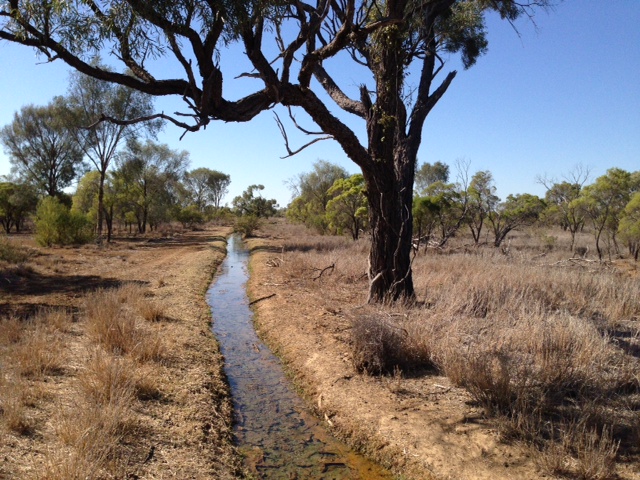 |
| A natural thermal gradient - the hot bores of outback Queensland |
- by Robbie Wilson
How do animals adapt to hot temperatures? What allows some animals to do well in hot conditions while others simply, well – die? Seems like a pertinent question when one considers the world is getting hotter. And quickly.
My current ARC Discovery Project poses these very questions. I want to understand the mechanisms of adaptation to warmer temperatures and how this can shape a species' population dynamics and survival.
It's not surprising then that my interest was piqued by rumours of an introduced species of freshwater fish (the ubiquitous mosquitofish) that can actually survive in the bath-hot bore drains of western Queensland.
Across the state's west, numerous deep bores tap into the rich underground water sources of the Great Artesian Basin. Water spews out of these pipes from depths of more than 1500m at temperatures in excess of 70°C, flowing into narrow drains and cooling – allowing livestock to persist in an environment that would be otherwise uninhabitable. Fish (well, so the rumours go) inhabit these open drains at year-round temperatures above 30°C and sometimes even greater than 40°C. The possibility of capturing and studying these fish was too tempting to ignore.
 |
| RA Skye Cameron + echidna |
My RA and lab organising force Skye is used to my crazy, impetuous ideas, and she doesn't even seem surprised when my ideas are offered at stupidly short notice and without any respect for logistics. In this specific case, Skye laughed – and started packing – when I suggested we should head out west in search of some hot fish in just a few days’ time. We would collect some fish from hot bores to study in the lab. It was the prospect of teaming-up with some UQ colleagues that work out near Barcaldine (1200 km north-west of Brisbane) who know the local people, properties and bore-drain locations that lit a fire under my b-hind.
So - it was early on a Monday morning that Skye picked me up half-asleep (me, not her) and we set-off on our adventure with no guarantees of success (let's face it, little chance of success). By lunchtime on Tuesday we reached Barcaldine. We'd avoided suicidal kangaroos and emus playing chicken with every vehicle pelting along the highway, and we rendezvoused with Jeremy (RA) and Billie (Honours) – from my colleague Rod Fensham's lab group – at the local bakery. Incidentally, Rod and Jeremy work on the spring systems of Edgbaston - the site of Australia's most endangered freshwater fish, the red-finned blue-eye (more on this another time).
 |
| we had to stop driving at dusk as the emus and kangaroos made the roads dangerous |
After the obligatory orientation tour of the town's pubs on Tuesday evening and a sampling (2 kgs) of the local beef (not by Skye), we set off in search of bores on Wednesday morning. It didn't take long before we found them.
The first property we visited had a bore flowing out at 55°C into a tiny, narrow drain. Over the course of 30 m, the water cooled down to temperatures of around 45°C, and as we walked along the drain we spotted our first hot candidates. Little juvenile mosquito fish living at 42.8°C. Holy be-jesus!! This temperature is higher than I thought possible for any mosquito fish to survive in.
It was incredible - fish living in water I found hot to the touch.
 |
| mosquitofish were found at temperatures as (naturally) hot as 42.8 degC |
Walking along the drain revealed a beautiful temperature gradient that dropped down by around 1°C every 5 meters. When we hit temperatures of around 35°C there was an absolute explosion of fish and the surface rippled with movement. We'd found our hot fish – and in truly staggering numbers. The air temperature was just a little over 20°C – and it was dropping nightly to below 5°C – yet the fish were enjoying balmy water. These fish had found their stable, warm conditions and were clearly loving it.
 |
| kangaroos - as far as the eye could see |
By the end of the next day, we'd collected mosquitofish from two more sites and were ready to head back to Brisbane with a troop-carrier full of bore water and thermophilic fish. All we had to do was avoid those roos and make it back for my daughter Nelle's birthday party by 11am Saturday (Happy Birthday Princess).
And we did. I was only 30 minutes late to the party …
Robbie
